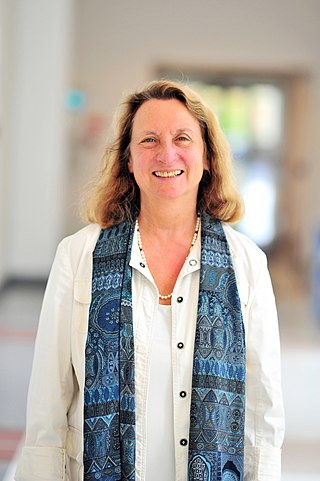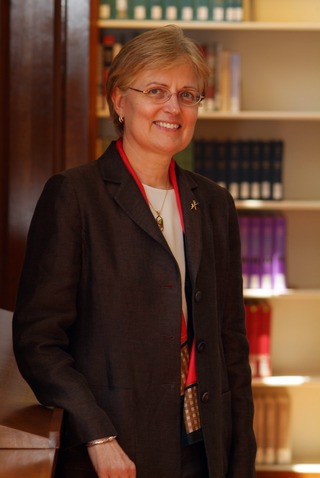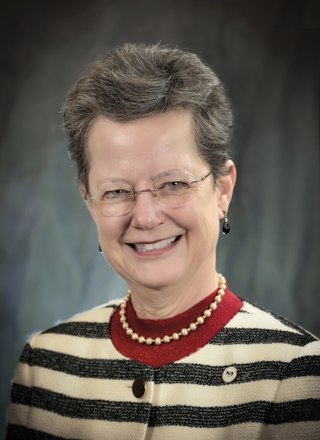Related Research Articles

Jacqueline K. Barton, is an American chemist. She worked as a professor of chemistry at Hunter College (1980–82), and at Columbia University (1983–89) before joining the California Institute of Technology. In 1997 she became the Arthur and Marian Hanisch Memorial Professor of Chemistry and from 2009 to 2019, the Norman Davidson Leadership Chair of the Division of Chemistry and Chemical Engineering at Caltech. She currently is the John G. Kirkwood and Arthur A. Noyes Professor of Chemistry, Emerita.

Manson Benedict was an American nuclear engineer and a professor of nuclear engineering at the Massachusetts Institute of Technology (MIT). From 1958 to 1968, he was the chairman of the advisory committee to the U.S. Atomic Energy Commission.

Mildred Cohn was an American biochemist who furthered understanding of biochemical processes through her study of chemical reactions within animal cells. She was a pioneer in the use of nuclear magnetic resonance for studying enzyme reactions, particularly reactions of adenosine triphosphate (ATP).

Mary Lowe Good was an American inorganic chemist who worked academically, in industrial research and in government. Good contributed to the understanding of catalysts such as ruthenium which activate or speed up chemical reactions.
Joanna Sigfred Fowler is a scientist emeritus at the U.S. Department of Energy's Brookhaven National Laboratory in New York. She served as professor of psychiatry at Mount Sinai School of Medicine and director of Brookhaven's Radiotracer Chemistry, Instrumentation and Biological Imaging Program. Fowler studied the effect of disease, drugs, and aging on the human brain and radiotracers in brain chemistry. She has received many awards for her pioneering work, including the National Medal of Science.

Esther Marley Conwell was a pioneering American chemist and physicist, best known for the Conwell-Weisskopf theory that describes how electrons travel through semiconductors, a breakthrough that helped revolutionize modern computing. During her life, she was described as one of the most important women in science.

Frances Hamilton Arnold is an American chemical engineer and Nobel Laureate. She is the Linus Pauling Professor of Chemical Engineering, Bioengineering and Biochemistry at the California Institute of Technology (Caltech). In 2018, she was awarded the Nobel Prize in Chemistry for pioneering the use of directed evolution to engineer enzymes.

Elaine Surick Oran is an American physical scientist and is considered a world authority on numerical methods for large-scale simulation of physical systems. She has pioneered computational technology to solve complex reactive flow problems, unifying concepts from science, mathematics, engineering, and computer science in a new methodology. An incredibly diverse range of phenomena can be modeled and better understood using her techniques for numerical simulation of fluid flows, ranging from the tightly grouped movements of fish in Earth's oceans to the explosions of far-flung supernovae in space. Her work has contributed significantly to the advancement of the engineering profession.

Elsa Reichmanis is an American chemist, who was the 2003 president of the American Chemical Society. She was elected a member of the National Academy of Engineering in 1995 for the discovery, development, and engineering leadership of new families of lithographic materials and processes that enable VLSI manufacturing. She was also inducted into the National Academy of Inventors in 2020. She is currently the Anderson Endowed Chair in Chemical and Biomolecular Engineering at Lehigh University. She previously served on the faculty at The Georgia Institute of Technology. Reichmanis is noted for her research into microlithography, and is credited for contributing to the "development of a fundamental molecular level understanding of how chemical structure affects materials function leading to new families of lithographic materials and processes that may enable advanced VLSI manufacturing".

Nancy Beth Jackson was an American chemist. She did energy research on heterogeneous catalysis and the development of alternative fuels. She also worked in the field of chemical nonproliferation, educating chemical professionals on the importance of safe and secure chemical practice in research, teaching and business, in an effort to prevent the misuse of chemicals as "weapons, poisons, explosives or environmental pollutants". She was the first implementer in developing the international Chemical Security Engagement Program. She was active in promoting diversity in STEM fields. She was president of the American Chemical Society in 2011, leading the organization during the International Year of Chemistry. In 2012, she was honored with the AAAS Award for Science Diplomacy.

Emily A. Carter is the Gerhard R. Andlinger Professor in Energy and the Environment and a professor of Mechanical and Aerospace Engineering (MAE), the Andlinger Center for Energy and the Environment (ACEE), and Applied and Computational Mathematics at Princeton University. She is also a member of the executive management team at the Princeton Plasma Physics Laboratory (PPPL), serving as Senior Strategic Advisor and Associate Laboratory Director for Applied Materials and Sustainability Sciences.

Ganapati Dadasaheb Yadav is an Indian chemical engineer, inventor and academic, known for his research on nanomaterials, gas absorption with chemical reaction and phase transfer catalysis. He served as the vice chancellor of the Institute of Chemical Technology, Mumbai from 2009 until November 2019. He is currently the Emeritus Professor of Eminence at ICT Mumbai.
Dorothy M. Hoffman was an American chemical engineer. In 1974 she became the first woman to be elected president of American Vacuum Society and the first woman to serve as president of any scientific society in the USA.
Jacqueline H. Chen is an American mechanical engineer. She works in the Combustion Research Facility of Sandia National Laboratories, where she is a Senior Scientist. Her research applies massively parallel computing to the simulation of turbulent combustion.

LaShanda Teresa James Korley is a Distinguished Professor of Materials Science at the University of Delaware and an expert in soft matter, polymers, and nature-inspired materials. On a larger scale, Korley is also working on developing strategies and technologies to prevent plastic waste in landfills and oceans by upcycling plastic waste to more valuable products. She leads such efforts through the Center for Plastics Innovation, the Center for Research in Soft Matter and Polymers, and also the Center for Hybrid, Active, and Responsive Materials (CHARM). Korley was awarded the 2019 National Organization for the Professional Advancement of Black Chemists and Chemical Engineers Lloyd N. Ferguson Young Scientist Award for Excellence in Research.
Susmita Bose is an Indian-American scientist and engineer, best known for her research on biomaterials, 3D printing or additive manufacturing of bone implants and natural medicine. She is the Herman and Brita Lindholm Endowed Chair Professor in the School of Mechanical and Materials Engineering at Washington State University.
Sue Brannon Clark is an environmental radiochemist. Since receiving her doctorate in inorganic and radiochemistry from Florida State University in 1989, Clark has worked at Washington State University where she leads a research team on the chemistry and chemical engineering of processing nuclear materials. She has also held various leadership roles at WSU, including serving as interim vice chancellor for academic affairs and interim dean of the college of sciences.

Rachel A. Segalman is the Edward Noble Kramer Professor and Department Chair of Chemical Engineering at University of California, Santa Barbara (UCSB). Her laboratory works on semiconducting block polymers, polymeric ionic liquids, and hybrid thermoelectric materials. She is the associated director of the Center for Materials for Water Energy System, an associate editor of ACS Macro Letters, and co-editor of the Annual Review of Chemical and Biomolecular Engineering.

Julia Mae Phillips is an American physicist. She began her career in materials research on thin films on semiconductors and has transitioned into leadership roles in science policy. She currently serves on the National Science Board.
Hope A. Michelsen is an American physical chemist and combustion scientist whose research involves the byproducts of combustion including soot, black carbon, greenhouse gases, the contribution of these substances to global warming, and the use of laser-induced incandescence to measure combustion products. She is an associate professor of mechanical engineering at the University of Colorado Boulder, in the Paul M. Rady Department of Mechanical Engineering.
References
- ↑ "Tina M. Nenoff", People, Sandia National Laboratories, retrieved 2024-02-16
- 1 2 Singer, Neal (February 23, 2023), "Sandia Fellow Tina Nenoff: It's all about materials", Sandia LabNews, Sandia National Laboratories, retrieved 2024-02-16
- 1 2 3 4 Rummler, Troy (January 30, 2020), "A material benefit to society: Sandia scientist elected 2019 AAAS fellow", Sandia LabNews, Sandia National Laboratories, retrieved 2024-02-16
- 1 2 3 4 Rappe, Mollie (August 2016), "Tina Nenoff tailored molecular sponges to pull radioactive ions from nuclear waste", Sandia News, Sandia National Laboratories, retrieved 2024-02-16
- 1 2 3 Madsen, Lynnette (2016), "Profile 71: Tina M. Nenoff", Successful Women Ceramic and Glass Scientists and Engineers: 100 Inspirational Profiles, John Wiley & Sons, pp. 425–426, ISBN 9781118733714
- 1 2 3 Nenoff Bio (PDF), Sandia National Laboratories, 2018, retrieved 2024-02-16
- ↑ Nenoff, Tina M. (Winter 2023), "Research Informed by Integrity and Ethics: 2022 Achievement Award Remarks", SWE: Magazine of the Society of Women Engineers, retrieved 2024-02-16
- ↑ "Achievement Award: Tina M. Nenoff, Ph.D.", SWE: Magazine of the Society of Women Engineers, 2022, retrieved 2024-02-16
- ↑ National Academy of Engineering Elects 114 Members and 21 International Members, National Academy of Engineering Elects 114 Members and 21 International MembersNational Academy of Engineering, retrieved 2024-02-16